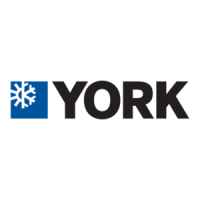
Do you have a question about the York D1CG300 and is the answer not in the manual?
| Brand | York |
|---|---|
| Model | D1CG300 |
| Category | Air Conditioner |
| Language | English |
Key safety measures for handling and operating the unit, particularly concerning gas.
Procedures for inspecting the unit for damage upon receipt and reporting any issues.
List of available forms for detailed information on installation, operation, and service.
Details on ETL and CGA design certifications for the unit's intended use.
Notes regarding strict compliance with installation instructions and codes to prevent damage.
Alerts about potential personal injury or property damage from incorrect installation.
National and local safety codes that must be followed during installation.
Guidelines for choosing an appropriate installation site, considering airflow and exposure.
Safe procedures for moving and lifting the unit, including equipment and techniques.
Specifications for maintaining adequate space around the unit for operation and service.
Recommendations for designing supply and return air duct systems based on ACCA standards.
Instructions for installing the pre-assembled damper baffle for outdoor air intake.
Requirements for connecting the condensate drain line in compliance with local codes.
Information on compressor mounting and filter installation and maintenance.
Locations of removable panels providing access to internal components for service.
Diagrams for connecting various thermostat types for cooling and heating operations.
Guidance for connecting the main power supply to the unit's control box.
Table specifying wire sizes and maximum lengths for control wiring based on current.
Recommendations for optimal thermostat placement and wiring connections.
Conformity requirements for field wiring to National Electrical Code and Canadian Electrical Code.
Instructions for wiring optional electric heaters for DCE models.
Details on discharging combustion products and installing vent hoods for DCG models.
Guidance on sizing, routing, and connecting gas supply lines for DCG units.
Information on converting units for L.P./propane gas and related piping requirements.
Instructions for installing vent and combustion air hoods for DCG models.
Guidance for field assembly and installation of an economizer/motorized damper rain hood.
Procedure for setting the enthalpy set point and checking damper movement.
Details on the installation of power exhaust/barometric relief damper and rain hood.
Description of the factory-charged air-cooled condenser cooling section.
Procedure for energizing crankcase heaters and initial compressor start-up.
Operation sequence for cooling when no outdoor air options are selected.
Operation sequence for cooling with a single enthalpy sensor and economizer.
Operation sequence for cooling with dual enthalpy sensors and economizer.
Combined operation of economizer and power exhaust systems.
Operation sequence for units with motorized outdoor air dampers.
Method for enabling continuous blower operation via thermostat setting.
Description of safety controls like suction line freezestat and high pressure cutout.
Sequence of operation for electric heating based on thermostat settings.
Guidelines for setting heat anticipators to ensure correct heating cycle length.
Step-by-step description of how the gas heating section operates.
Overview of safety controls specific to the gas heating system, including limit controls and redundant valves.
Table providing AMP settings for TH1 and TH2 based on heater KW and voltage.
Essential checks to perform before initial unit start-up, including gas type and hood installation.
Instructions for initiating pilot and main burner ignition sequence.
Procedure for adjusting the automatic gas valve to set manifold gas pressure.
Procedure for checking and adjusting the pilot flame for proper sensor coverage.
Methods for checking and adjusting supply air CFM using blower performance data.
Steps for accessing and servicing burners, pilots, and orifices.
Procedure for adjusting air shutters to achieve a blue flame appearance.
Method for measuring pressure drop across the evaporator coil to determine CFM.
Procedure for adjusting blower CFM to achieve the specified temperature rise.
Instructions for adjusting belt tension and pulley settings for optimal blower performance.
Procedure for measuring and verifying natural gas input rate using the gas meter.
Monthly inspection and replacement or cleaning of air filters.
Guidelines for maintaining indoor and outdoor fan motors, including lubrication.
Annual checks for pilot and main burner flames, and cleaning of components.
Steps for cleaning heat exchanger passages and flue baffles.
Diagnosing and resolving issues with the indoor blower motor not running.
Troubleshooting steps when the draft motor runs but the blower does not start in AUTO mode.
Diagnosing problems when the draft motor runs but the pilot does not ignite.
Addressing issues causing pilot or control lock-out, including temperature conditions.
Troubleshooting for pilot ignition failure with or without gas odor detected.
Resolving problems with main burner ignition, erratic flame, or delayed ignition.

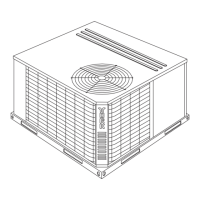

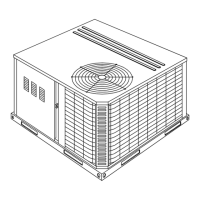




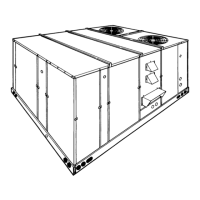
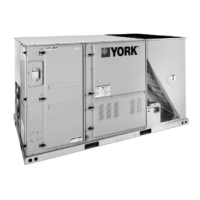

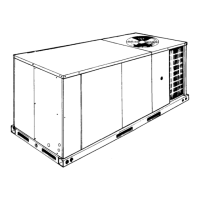
